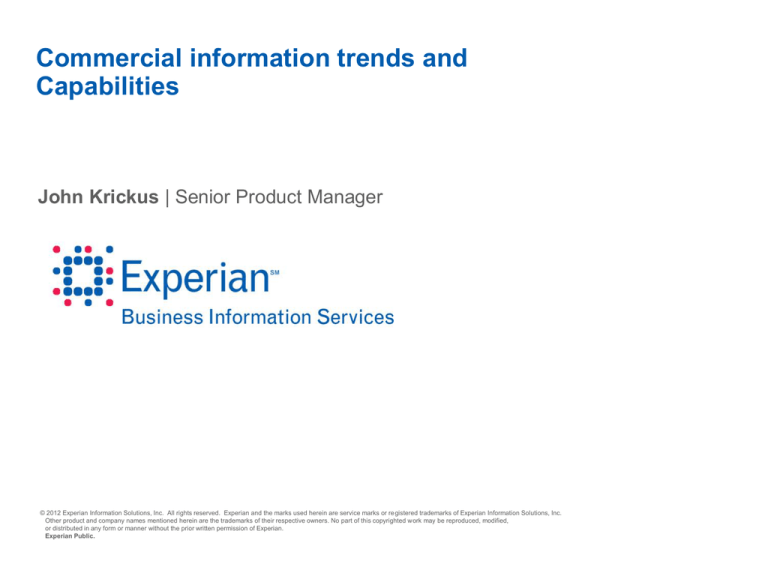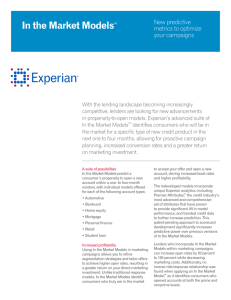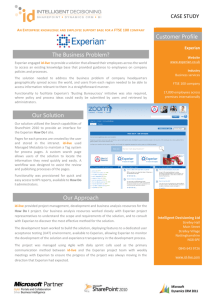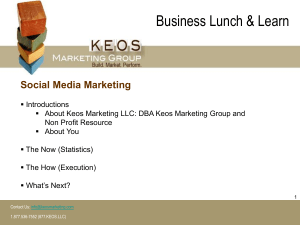
Commercial information trends and
Capabilities
John Krickus | Senior Product Manager
© 2012 Experian Information Solutions, Inc. All rights reserved. Experian and the marks used herein are service marks or registered trademarks of Experian Information Solutions, Inc.
Other product and company names mentioned herein are the trademarks of their respective owners. No part of this copyrighted work may be reproduced, modified,
or distributed in any form or manner without the prior written permission of Experian.
Experian Public.
Agenda
Business failure and payment delinquency
dynamics
Mortgage crisis and small business owners
Business failure performance results
Deploying “the grid” for your risk issues
Commercial information for insurance
modeling
© 2012 Experian Information Solutions, Inc. All rights reserved.
Experian Public.
2
Business failure/default and
payment delinquency dynamics
Small Business Owners and the Mortgage Crisis
© 2010 Experian Information Solutions, Inc. All rights reserved.
Experian Public.
3
National payment delinquency trends
Stabilizing, but companies still cautious with cash
Risk score show slight
increases across all regions
DBT (days beyond terms)
stabilizing but remains elevated
vs. prior year, up 14%
Business benchmark trends
Key categories all declining
Category
Q4-11
Change*
60.54
0.7%
7.3
1.6%
% Delinquent
10.3%
1.4%
$ 91+
6.5%
1.7%
Risk score
DBT
Slight increase in dollars
delinquent
Within aging categories more
dollars going 91+
© 2012 Experian Information Solutions, Inc. All rights reserved.
Experian Public.
* Versus six months prior
Trend
4
Size of business – percentage of payments 91+
Payment delinquency is best sign of small business stress
15%
12%
9%
6%
3%
0%
N/E
1-4
5-9
10-19
20-49
50-99
100-249
250-499
500-999
1000+
Larger businesses manage cash flow but do not stretch payments out beyond 91+
Smaller businesses have highest rate of severe delinquency as they wait for payment
© 2012 Experian Information Solutions, Inc. All rights reserved.
Experian Public.
5
Model: Financial Stability Risk ScoreSM addresses
bankruptcy and severe stress
Less than 10% of business “deaths” file for bankruptcy
What causes a business failure?
Bankruptcy filings represent a small, but not insignificant segment
Business stress and ultimately failure driven by competition,
economics, and business practices
Unexpected personal health or natural/man made disasters
can end a business, difficult to predict
Starts and closures of employer firms, 2005 to 2009
Category
2005
2006
2007
2008
2009
Births
644,122
670,058
668,395
626,400
552,600
Closures
565,745
599,333
592,410
663,900
660,900
Bankruptcies
39,201
19,695
28,322
43,546
60,837
SOURCE: U.S. Department of Commerce, Census Bureau
© 2012 Experian Information Solutions, Inc. All rights reserved.
Experian Public.
6
Small business owners with mortgage problems
Consumer obligation delinquency trends
Percent of consumer trades 90+ delinquent
70%
Percent 90+ delinquent
60%
59%
Severe mortgage delinquency
Base line: No mortgage delinquency
50%
40%
30%
17%
20%
10%
3.6%
0%
Q-4
Q-3
Q-2
Q-1
90+
mort del
Q+1
Q+2
Q+3
Q+4
Significant increase in consumer credit delinquency, from 17% to 59%
© 2012 Experian Information Solutions, Inc. All rights reserved.
Experian Public.
7
Small business owners with mortgage problems
Commercial payment delinquency trends
Percent of commercial trades 90+ delinquent
9%
7.7%
Percent 90+ delinquent
Severe mortgage delinquency
Base line: No mortgage delinquency
6%
3.6%
3%
1.3%
0%
Q-4
Q-3
Q-2
Q-1
90+
mort del
Q+1
Q+2
Q+3
Q+4
Delinquent payments only increased to 7.7% protecting their business credit
as they let their consumer credit deteriorate
© 2012 Experian Information Solutions, Inc. All rights reserved.
Experian Public.
8
Commercial average high credit usage
Average commercial single trade recent high credit
Average recent high credit
$10,000
Severe mortgage delinquency
Base line: No mortgage delinquency
$8,000
$6,000
$4,000
$2,000
$0
Q-4
Q-3
Q-2
Q-1
90+
mort del
Q+1
Q+2
Q+3
Q+4
Increased dependence on business credit lines
© 2012 Experian Information Solutions, Inc. All rights reserved.
Experian Public.
9
Key findings
Small business owners with mortgage trouble
were placing more importance on paying their
business credit obligations over their personal
obligations, including their mortgage
This group is likely to sacrifice their home in
order to keep the business and preserve the
source of their income
The finding was a surprise as conventional
wisdom has been that the mortgage
is always paid first
© 2012 Experian Information Solutions, Inc. All rights reserved.
Experian Public.
10
Business failure
performance results
Use of “the Grid”
© 2010 Experian Information Solutions, Inc. All rights reserved.
Experian Public.
11
Financial Stability model process
Developed from 1.3 million records, all with “clean” data
Bad definition: Firms filing bankruptcy / firms where GT 75% of trade dollars
are 91+ and / or negative trade comments for multiple quarters and at the end
3% “bad” rate
All with
“clean” data
No bad
performance
Month 0
Observation point
“Bads”
observed in
sample
Performance window
Month 12
What archived data from the observation point, when all records had “clean” data,
would have predicted the “bads” at the end of the performance window in month 12
SOURCE: Experian Business Information Services
© 2012 Experian Information Solutions, Inc. All rights reserved.
Experian Public.
12
Model process: Financial Stability Risk ScoreSM factors
Common elements among stressed businesses
Key factors correlated with business stress
Payments: 91+ and 61+ status,
past delinquency
Credit utilization: High ratio of outstanding
balances vs. previous high credits
Derogatories: Collection trades and lien
and judgment filings
Firmagraphics: Younger businesses
and industry risk
SOURCE: U.S. Department of Commerce, Census Bureau
© 2012 Experian Information Solutions, Inc. All rights reserved.
Experian Public.
13
Financial Stability Risk ScoreSM model performance
“bad capture” – Bottom 20% captures 74% of “bads”
Bottom percent of Financial Stability Risk ScoreSM or cut-off level
© 2012 Experian Information Solutions, Inc. All rights reserved.
Experian Public.
14
Financial Stability Risk ScoreSM performance
By industry
Percentage of file
Average Financial Stability Risk ScoreSM
Agriculture / mining
1%
67
Health services
6%
66
Public administration
2%
63
Wholesale
5%
60
Legal services
2%
57
Hotels / lodging
1%
55
Insurance
2%
55
Manufacturing
5%
53
Construction
14%
50
Real estate
5%
47
Finance
2%
44
Retail
20%
43
Transportation
3%
39
Services
17%
37
Industry
© 2012 Experian Information Solutions, Inc. All rights reserved.
Experian Public.
15
“The Grid”
Identify slow pay, BUT will pay
Financial Stability Risk ScoreSM
High score
Low score
High score
82%
PlusSM
Medium risk Intelliscore
with high financial stability risk
2%
Intelliscore
PlusSM
Stable, low risk segment
8%
8%
Low score
High risk for both events,
target segment for deposits
The key segment, WILL PAY
despite SLOW PAY
SOURCE: Experian Business Information Services
© 2012 Experian Information Solutions, Inc. All rights reserved.
Experian Public.
16
Commercial information
for insurance modeling
© 2010 Experian Information Solutions, Inc. All rights reserved.
Experian Public.
17
Four main groups of data
Firmographics
Public records
Address
Liens
Phone
Judgments
SIC, number
of employees
UCC filings
Sales
Bankruptcy
Scoring
Trade
Intelliscore
PlusSM
Number and
percent of
trades by aging
categories,
categories of
trade and
collection data
Key score
factors
Over 660 data elements
© 2012 Experian Information Solutions, Inc. All rights reserved.
Experian Public.
18
Value of information
Insurance analysis methodology
Univariate analysis: 200 Experian credit variables vs. instance of loss
within a 12-month window
►
Rank-ordered variables (information value)
►
Multiple client loss results
Segmented into “good” and “bad” distributions
Findings
Credit score is a good, but not the sole indicator of potential loss
►
►
On average commercial credit scores indicate loss 60-80% of the time
Optimize by combining credit and internal data variables in a custom
insurance score
© 2012 Experian Information Solutions, Inc. All rights reserved.
Experian Public.
19
Top-11 variables
Rank / business aggregate / description
1
TOT111
Total number of trades
reported within 12 months
of the profile date
2
TOT212
Total high credit balance
3
TOT102
Total number of active trades
7
Total
account
balance
Total $ trade balance for all
trade lines on business
8
TOT260
Total account balance that is
current across all trades
TOT121
Total number of trades with
last activity within 12 months
of profile date
9
TOT101
Total number of trades
10
REG230
Average balance that is
current over the past six
months for regular trades
5
TOT110
Total number of trades
reported within six months of
the profile date
11
IND101
Total number of regular trades
6
TOT201
Total account balance
4
© 2012 Experian Information Solutions, Inc. All rights reserved.
Experian Public.
20
Use of consumer predictive data
Blending owner / guarantor information with commercial data
Powerful predictive consumer
data elements
►
►
►
Number of accounts
recently delinquent
Number of derogatory
payment accounts
File OneSM database structure
Trades
tables
Public record
tables
PIN
Consumer
tables
Number of accounts
with 90% utilization
PIN
►
Number of bankcards
with 100%+ utilization
►
Number of inquiries
►
Real estate delinquency
PIN
Inquiry
tables
© 2012 Experian Information Solutions, Inc. All rights reserved.
Experian Public.
AIN
Address
tables
PIN
Employment
tables
21
Current insurance industry file use examples
National P&C, full national file, consultant custom model for renewals
news, accesses new account on-line and may obtain other data
►
Archives files received for ongoing model development
Regional worker’s comp, 26 state coverage, went with Experian BIS
for hit rate improvement; consultant model recently moved to
internal custom model
National full lines, starting with existing portfolio, developing model
with quarterly file scoring, new account model
Regional P&C, 29 states, using consultant custom model
Flexible file process meets needs for national / state coverage,
full data file or selected data elements, web or direct connection access
© 2012 Experian Information Solutions, Inc. All rights reserved.
Experian Public.
22
Business information analytics
Available to you on the Web at…
Small Business Bankruptcies
© 2012 Experian Information Solutions, Inc. All rights reserved.
Experian Public.
23
© 2010
2012 Experian Information Solutions, Inc. All rights reserved.
Experian Public.
24





